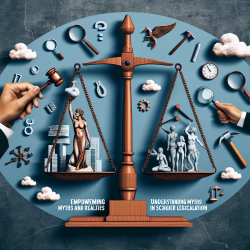Empowering Change: Understanding Myths and Realities in Sex Offender Legislation
In the realm of criminal justice, the socially constructed realities surrounding sex offenders are often mired in myths and misconceptions. This blog seeks to empower practitioners by shedding light on the outcomes of the research conducted by Kyle A. Burgason, which examines the influence of laws, myths, and claims-making on sex offenders' realities. By understanding these dynamics, practitioners can improve their skills and contribute to more informed policy-making.
Understanding the Influence of Myths
The research highlights how myths surrounding sex offenders can lead to urban legends that shape public perception and policy. These myths, often perpetuated by media and claims-makers, create a distorted reality for offenders, their families, and communities. Practitioners need to be aware of these myths to address the root causes of public fear and misinformation.
The Role of Claims-Makers
Claims-makers play a crucial role in constructing social realities. They use myths to generate public fear and pressure policymakers to enact laws that promise false security. Practitioners can improve their skills by critically evaluating the claims presented in media and public discourse, ensuring that their actions are based on empirical evidence rather than myths.
Legal Implications and Policy Recommendations
The research outlines the historical context of sex offender laws, from colonial America to the present cyber age. It highlights how laws have been influenced by public fear and myths, leading to policies that may not effectively address the real issues. Practitioners can advocate for policy changes that are informed by evidence and focus on rehabilitation and community safety.
Encouraging Further Research
Practitioners are encouraged to delve deeper into the research and explore the nuances of socially constructed realities. By engaging with the original research paper, practitioners can gain a comprehensive understanding of the complexities involved and contribute to more effective interventions and policies.
To read the original research paper, please follow this link: Using Loseke to examine the influence of laws, myths, and claims making on sex offenders’ socially constructed realities.










